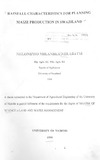| dc.description.abstract | The estimation of missing climatic data was done using the arithmetic mean method. It is
important to ascertain the homogeneity of any meteorological data before such data are used in any
research work. To investigate whether the data sets were homogeneous or not, the mass curve
method was employed.
Two graphical methods, the cumulative and the effective methods were used to determine
the times of onset and cessation of the rains in the growing season for the four agro-ecological
regions namely; Highveld, Middleveld, Lubombo Plateau and the Lowveld. The variability of
rainfall throughout the country was investigated based on the mean and the standard deviation.
Spectral analysis was done to see if there were cyclical rainfall events that recurred over time.
These were done for both seasonal (5 1 year) and cyclical (> 1 year) variations. The water
requirement satisfaction index (WRSI) was used to generate indices in the Highveld, which were
then used to predict maize yields. Correlation and regression analyses were used to develop a
model for predicting maize yields using the WRSI.
The cumulative rainfall method in all the four regions showed rains to begin between
September and October and cease in April. The effective rainfall method on the other hand showed
the effective rainfall season to be between October and March in three of the four regions The
effective rainfall method in the Lowveld region indicated crop water requirements were always
higher than the available soil water. Therefore, crop production without water stress in the lowveld
can only be practised under irrigation. Therefore, all primary tillage operations should be complete
by the fourth pentad of August, in readiness for planting. The effective rainfall method was found to
be the most appropriate to use in agricultural production and planning in this study.
The variability and reliability of the rainfall in both space and time showed that the Highveld
had the highest reliability and the Lowveld had the lowest variability. Spectral analysis showed that
there are events that recur after 90 days, 35 days, 25 days, and 10 - 15 days. These cycles are a
manifestation of the Julian- Madden Cycle within the growing season. Cyclical variations of about
2 years (Quasi - Biennial Oscillation, QBO), 3 - 7 years (EI-Nifi.o/Southern Oscillation, ENSO) and
longer than 10 years (sunspot or inter-decadal variability) were also observed. This can be
confirmed by the generally observed recurrence of above normal (wet) and below normal (dry)
events.
Correlation analysis showed that the yields were highly correlated to the WRSI indices. A
linear regression model expressing yield in terms of the indices, had a coefficient of determination
(r2) of54%.
A seasonal land management calendar for maize production was developed by this study;
taking into account the most common seasonal tillage operations. This study has shown that
primary tillage operations must be started well before ( 1-6 pentads) the onset of effective rainfall in
order to optimize soil moisture and crop yields. | en |

